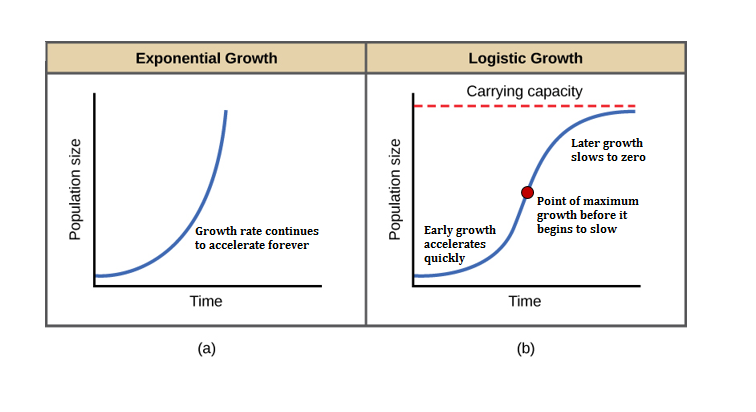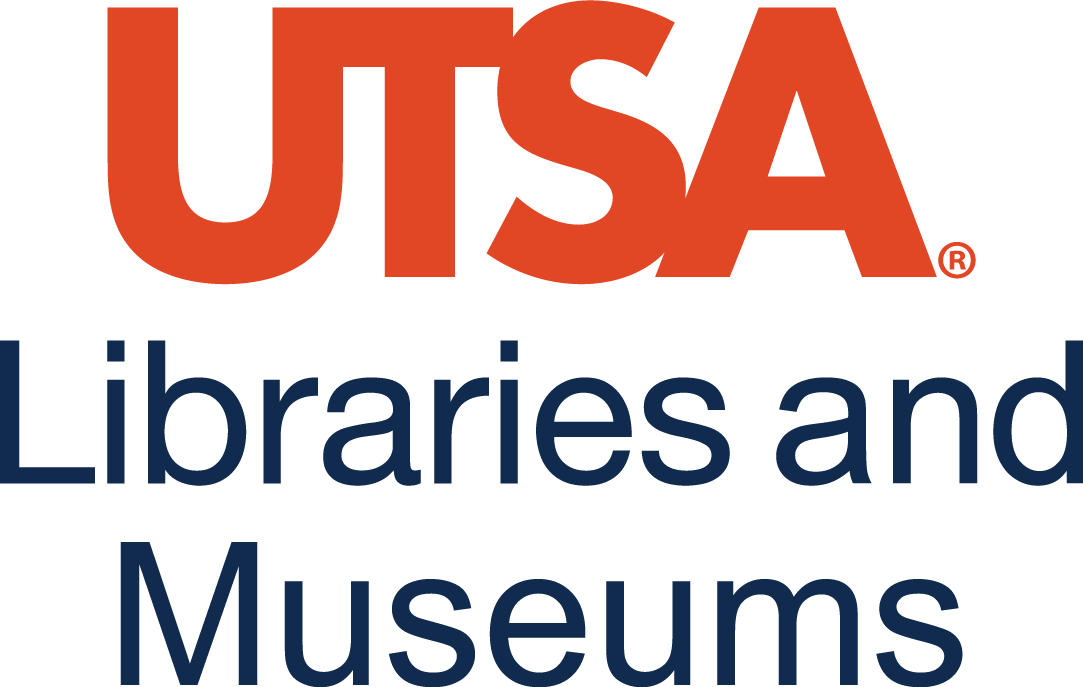23 Logistic Growth:
Topics Covered
Population ecologists make use of a variety of methods to model population dynamics. An accurate model should be able to describe the changes occurring in a population and predict future changes.
The two simplest models of population growth use deterministic equations (equations that do not account for random events) to describe the rate of change in the size of a population over time. The first of these models, exponential growth, describes theoretical populations that increase in numbers without any limits to their growth. The second model, logistic growth, introduces limits to reproductive growth that become more intense as the population size increases. Neither model adequately describes natural populations, but they provide points of comparison.
Exponential Population Growth[1]
Charles Darwin, in developing his theory of natural selection, was influenced by the English clergyman Thomas Malthus. Malthus published his book in 1798 stating that populations with abundant natural resources grow very rapidly; however, they limit further growth by depleting their resources. The early pattern of accelerating population size is called exponential growth.
The best example of exponential growth in organisms is seen in bacteria. Bacteria are prokaryotes that reproduce largely by binary fission. This division takes about an hour for many bacterial species. If 1000 bacteria are placed in a large flask with an abundant supply of nutrients (so the nutrients will not become quickly depleted), the number of bacteria will have doubled from 1000 to 2000 after just an hour. In another hour, each of the 2000 bacteria will divide, producing 4000 bacteria. After the third hour, there should be 8000 bacteria in the flask. The important concept of exponential growth is that the growth rate—the number of organisms added in each reproductive generation—is itself increasing; that is, the population size is increasing at a greater and greater rate. After 24 of these cycles, the population would have increased from 1000 to more than 16 billion bacteria. When the population size, N, is plotted over time, a J-shaped growth curve is produced (a).
The bacteria-in-a-flask example is not truly representative of the real world where resources are usually limited. However, when a species is introduced into a new habitat that it finds suitable, it may show exponential growth for a while. In the case of the bacteria in the flask, some bacteria will die during the experiment and thus not reproduce; therefore, the growth rate is lowered from a maximal rate in which there is no mortality. The growth rate of a population is largely determined by subtracting the death rate, D, (the number of organisms that die during an interval) from the birth rate, B, (the number of organisms that are born during an interval). The growth rate can be expressed in a simple equation that combines the birth and death rates into a single factor: k. This is shown in the following formula:
Population growth = (B-D)P
Population growth = kP
The value of k can be positive, meaning the population is increasing in size (the rate of change is positive); or negative, meaning the population is decreasing in size; or zero, in which case the population size is unchanging, a condition known as zero population growth.
Logistic Population Growth[2]
Extended exponential growth is possible only when infinite natural resources are available; this is not the case in the real world. Charles Darwin recognized this fact in his description of the “struggle for existence,” which states that individuals will compete (with members of their own or other species) for limited resources. The successful ones are more likely to survive and pass on the traits that made them successful to the next generation at a greater rate (natural selection). To model the reality of limited resources, population ecologists developed the logistic growth model.
Carrying Capacity and the Logistic Model
In the real world, with its limited resources, exponential growth cannot continue indefinitely. Exponential growth may occur in environments where there are few individuals and plentiful resources, but when the number of individuals gets large enough, resources will be depleted, and the growth rate will slow down. Eventually, the growth rate will plateau or level off (b). This population size, which is determined by the maximum population size that a particular environment can sustain, is called the carrying capacity, or L. In real populations, a growing population often overshoots its carrying capacity, and the death rate increases beyond the birth rate causing the population size to decline back to the carrying capacity or below it. Most populations usually fluctuate around the carrying capacity in an undulating fashion rather than existing right at it.
The formula used to calculate logistic growth adds the carrying capacity as a moderating force in the growth rate. The expression “L – P” is equal to the number of individuals that may be added to a population at a given time, and “L – P” divided by “L” is the fraction of the carrying capacity available for further growth. Thus, the exponential growth model is restricted by this factor to generate the logistic growth equation:
Population growth ![]()
Notice that when P is almost zero the quantity in brackets is almost equal to 1 (or L/L) and growth is close to exponential. When the population size is equal to the carrying capacity, or P = L, the quantity in brackets is equal to zero and growth is equal to zero. A graph of this equation (logistic growth) yields the S-shaped curve (b). It is a more realistic model of population growth than exponential growth. There are three different sections to an S-shaped curve. Initially, growth is exponential because there are few individuals and ample resources available. Then, as resources begin to become limited, the growth rate decreases. Finally, the growth rate levels off at the carrying capacity of the environment, with little change in population number over time.

Examples of Logistic Growth[3]
Yeast, a microscopic fungus used to make bread and alcoholic beverages, exhibits the classical S-shaped curve when grown in a test tube (a). Its growth levels off as the population depletes the nutrients that are necessary for its growth. In the real world, however, there are variations to this idealized curve. Examples of wild populations include sheep and harbor seals (b). In both examples, the population size exceeds the carrying capacity for short periods of time and then falls below the carrying capacity afterward. This fluctuation in population size continues to occur as the population oscillates around its carrying capacity. Still, even with this oscillation, the logistic model is confirmed.

The logistic model of population growth, while valid in many natural populations and a useful model, is a simplification of real-world population dynamics. Implicit in the model is that the carrying capacity of the environment does not change, which is not the case. The carrying capacity varies annually. For example, some summers are hot and dry whereas others are cold and wet; in many areas, the carrying capacity during the winter is much lower than it is during the summer. Also, natural events such as earthquakes, volcanoes, and fires can alter an environment and hence its carrying capacity. Additionally, populations do not usually exist in isolation. They share the environment with other species, competing with them for the same resources (interspecific competition). These factors are also important to understanding how a specific population will grow.
Key Concepts
- Logistic population growth
Population growth
![Rendered by QuickLaTeX.com = kP [\frac{L - P}{L}]](https://utsa.pressbooks.pub/app/uploads/quicklatex/quicklatex.com-9b8155a4e4142faefeaff590470cf9ab_l3.png)
- Section material derived from Openstax Concepts of Biology: Ecology-Populations and Community Ecology-Population Growth and Regulation; Access for free at https://openstax.org/books/concepts-biology/pages/1-introduction ↵
- Section material derived from Openstax Concepts of Biology: Ecology-Populations and Community Ecology-Population Growth and Regulation ↵
- Section material derived from Openstax Concepts of Biology: Ecology-Populations and Community Ecology-Population Growth and Regulation ↵
A rate of growth that increases in proportion to the original population
the leveling off of exponential growth due to limiting resources
the shape of an exponential growth curve
the number of deaths within a population at a specific point in time
the number of births within a population at a specific point in time
the steady population size where birth rates and death rates are equal
the maximum number of individuals of a population that can be supported by the limited resources of a habitat
the shape of a logistic growth curve

